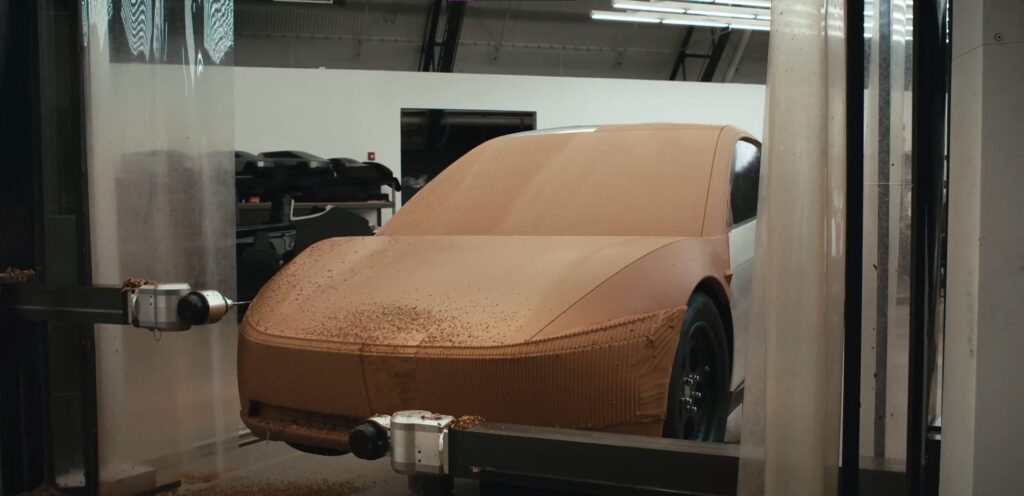Tesla recently unveiled its Master Plan Part 4, which left many fans speculating about the future direction of the company. However, it was a promotional video released alongside the document that caught the attention of eagle-eyed viewers. In the background of a segment showcasing a clay model of Tesla’s upcoming Cybercab robotaxi in the Design Studio, two never-before-seen vehicle designs were spotted on a shelf. These designs included a minivan-style vehicle and a large SUV, both bearing the distinctive design language of the Cybertruck.
The SUV model featured a blockier front fascia and a taller rear end, hinting at a more family-friendly design compared to the Cybertruck. On the other hand, the van-shaped model sparked interest in a potential Cybervan concept, which Tesla had previously teased with sketches of a Robovan alongside the Cybercab. While these designs generated excitement and speculation among fans, it is unlikely that they will see production. Tesla has stated that the Cybertruck’s stainless steel exoskeleton will not be carried over to future vehicles, and the company’s focus has shifted towards artificial intelligence, robotics, and energy solutions rather than expanding its vehicle lineup.
Despite the slim chances of these designs making it to production, the fact that Tesla explored Cybertruck-inspired concepts beyond the pickup itself is intriguing. Tesla CEO Elon Musk hinted at adding more specifics to Master Plan Part 4 in the future, but it is unlikely that any details regarding Cybertruck-inspired vehicles will be included. Whether a Cyber-SUV or Cybervan will ever become a reality remains uncertain, but the possibility of Tesla delving into new vehicle designs is an exciting prospect for fans of the brand.
In other Tesla news, the company recently broke sales records in Turkey with the Model Y, becoming the second-best-selling automotive brand in the country. Additionally, Tesla has expanded its Robotaxi rides to include freeways in Austin, marking a significant milestone in its autonomous driving program. Elon Musk also highlighted the importance of Tesla’s humanoid robot, Optimus, stating that it will represent a significant portion of the company’s value in the future.
Overall, Tesla continues to push boundaries and explore new technologies, leaving fans eagerly anticipating what the future holds for the innovative automaker. Recently, there has been a surge in interest in sustainable living practices as individuals and communities around the world are becoming more aware of the impact that their actions have on the environment. One of the key components of sustainable living is the concept of zero waste living, which aims to reduce, reuse, and recycle in order to minimize the amount of waste that is sent to landfills.
Zero waste living is a lifestyle choice that involves making conscious decisions about the products we use, the food we eat, and the waste we produce. It is about rethinking our consumption habits and finding ways to reduce our environmental footprint. This can involve practices such as composting food scraps, using reusable containers and bags, and choosing products that are made from sustainable materials.
One of the main principles of zero waste living is to focus on reducing the amount of waste that we produce in the first place. This can involve making choices such as buying products with minimal packaging, opting for reusable items instead of disposable ones, and choosing products that are designed to last a lifetime. By making these small changes in our daily lives, we can significantly reduce the amount of waste that ends up in landfills.
Another key aspect of zero waste living is to focus on reusing items whenever possible. This can involve repairing broken items instead of throwing them away, repurposing old items for new uses, and borrowing or sharing items with others instead of buying new ones. By finding creative ways to reuse items, we can extend their lifespan and reduce the amount of waste that we produce.
Recycling is also an important part of zero waste living, as it allows us to divert waste from landfills and give new life to materials that would otherwise be discarded. By sorting our waste and recycling items such as paper, plastic, glass, and metal, we can help to conserve natural resources and reduce the environmental impact of our consumption habits.
Overall, zero waste living is a holistic approach to sustainability that focuses on reducing, reusing, and recycling in order to minimize our impact on the environment. By making conscious choices about the products we use and the waste we produce, we can work towards creating a more sustainable future for ourselves and future generations. It may take some time and effort to adopt a zero waste lifestyle, but the benefits for the planet are well worth it.

